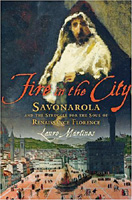home | metro silicon valley index | the arts | books | review

Fire in the City: Savonarola and the Struggle for the Soul of Renaissance Florence
REVIEW (By Lauro Martines; Oxford; 336 pages; $30 cloth)
—Michael S. Gant
Was the fiery preacher Savonarola a righteous reformer or just a Renaissance Jerry Falwell? Scholars have generally tended to condemn the Dominican firebrand, who, for a brief time in the 1490s, commanded the populace of Florence and defied the pope. It is easy to recoil from the strict enemy of luxuries, gambling and sexuality, whose fervent young followers famously gathered up "playing cards, dice, gaming tables, chess sets, wigs, mirrors, dolls" and the like in order to set them ablaze in great "bonfires of the vanities." Lauro Martines, who teaches history at UCLA, tries to balance the scales a bit in his sympathetic study of the priest, putting him in a political context that makes him look like more than just a fire-and-brimstone prude. By the time Savonarola's sermons ignited the masses, decades of secular corruption at the hands of the Medici family and religious rot from Rome had primed the citizens of Florence for a revival of morality and Republicanism. Playing a dangerous game, Savonarola gave a voting voice to the middle classes, railed against the selling of indulgences, preached genuine reform and welcomed the invading army of Charles VIII of France as the force that would scourge Rome "without mercy." Martines' narrative starts slowly and demands of the reader a great deal of thick sledding through the dense underbrush of Renaissance politics, but once the powers that be finally close in on the doomed priest, the pace tightens considerably. Finally, Savonarola's famous public hanging and immolation came with the abruptness of mob action. As Matines notes, "His plea for morality menaced the most powerful vested interests—the papacy itself, as well as cardinals, princes, political bosses and tight oligarchies."
Send a letter to the editor about this story.
|
|
|
|
|
|